|
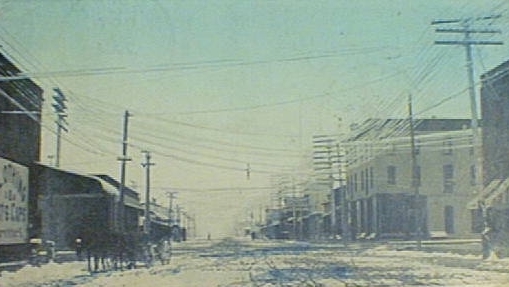
Center Street at Second St., looking south, Casper, May 17, 1907. Grand Central Hotel
on right.
Ah, Spring time in the Rockies! Actually, not all that unusual, but nevertheless,
the weather in the Casper area has been a topic of discussion since at least
1865.
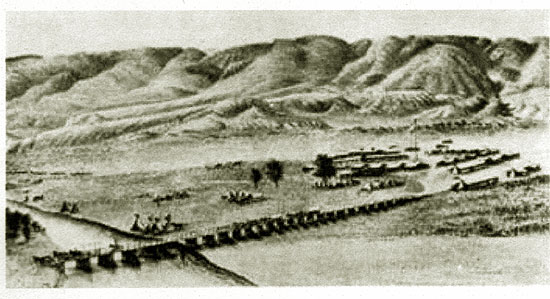
Platte River Bridge at Fort Caspar.
The 1865 diary of a Civil War soldier, Elijah Nelson Doughty, on patrol
and camping in the Platte River Valley near present day Casper contains the
following entries:
April 19: Snowing, in camp as usual. We have eat our breakfast. Have tied our
horses out in the brush to browse and shelter from the storms of this
country. It is now getting late and we have brought in our horses to feed
and groom them. We have eat some hard tack and bacon and will soon crawl
in our tents to shelter us from the miserable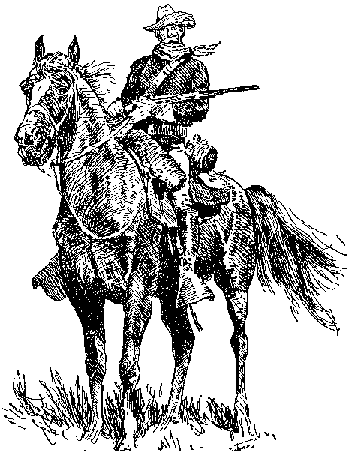 snow storms of this country.
snow storms of this country.
April 20: Got up to roll call and found it still snowing. It has now been
snowing for the last forty eight hours and no prospects of quiting anyways
soon. We have tied our horses in the brush as yesterday. Have eat our
breakfast and are now setting around our fires trying to keep warm. It is
now getting late and the snow fall as usual. Six of our boys started on
a three days hunt this morning.
April 21: Still snowing. One man killed and another wounded by the Indians
12 miles from here while carrying the mail from here to [Fort] Laramie.
The Indians were repulsed by six soldiers. The Indians numbered twenty
or more.
April 29: Remaining in camp. The weather has the appearance of spring.
The grass begins to grow slowly and has the appearance of summer.
May 2: The weather remains like summer. The boys are swimming Deer creek [Webmaster's note:
This would place the camp at present day Glenrock, about 26 miles east of
present day Casper. See photos of Glenrock at bottom of page.].
The water cold as snow. We have guard mount drill once a day. The boys makes
a skift out of a beef hide and quite a number of the boys has been ducked
by the use of their new skift.
May 4: A.D. 1865: Warmer yet today and lazy weather for shaved heads.
Our boys who was left at Riley came up with the mail party except a few
to wit: B. F. Norton, W. H. Norton, N. H. Norton, Grerry W. C. Haselwood,
S. Barker, J. A. Norton and James Hames. The above named soldiers will be
discharged. the water still keeps up.
May 5: This morning a detachment of thirty men from each Co., of the Regt.
starts to Powder river on a ten day scout to break up some Indian
villages which are said to be out there. It snows and rained here last
night and consequently the weather is quite cold today.
May 9: Snowed last night and is still snowing. We have eat our grub
and again taken refuge in our poor though quite comfortable tents
considered by us at this late hour. It is now night and the snow has
fallen all day and looks like winter.
May 10: The sun shines out brilliant this morning, again assumes the
appearance of summer. The grass went up the spout last night you bet.
The snow is fast melting this nice morning.
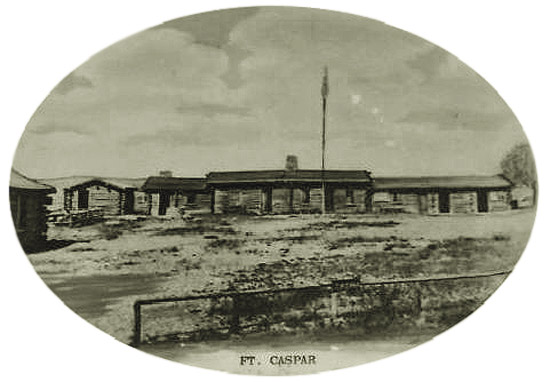
Fort Caspar, artist unidentified.
As suggested in the diary entries, problems with the Indians were beginning to come
to a head. As related on the discussion of Indian Wars, later in 1865 the Fetterman massacre occurred with the subsequent withdrawal
of military forces from Fort Kearney. In the area of present day Casper
the problem with Indians also arose. With the Treaty of Fort Laramie, Fort Caspar was abandoned.
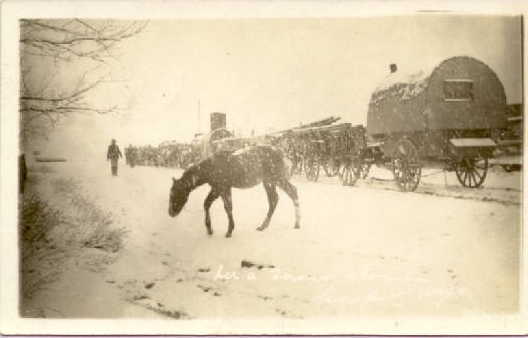
Casper, 1907
In the 1880's the Chicago & Northwestern Railroad, under the leadership of its general manager, Marvin
Hughitt, began a vigorous expansion of its system. A subsidiary, the Fremont, Elkhorn & Missouri Valley Railroad Company,
began pushing westward through the Dakotas and Nebraska heading for the Black Hills. By
1885 it had reached Chadron, Nebraska. In Wyoming, the railroad pushed along the Niobrara River in search of
coal near present day Shawnee. With the expansion of the cattle industry, Hughitt determined that the
western terminus should be on the north bank of the North Platte west of Fort Fetterman possibly near the location of the
C Y Ranch owned by J. M. Carey. This would provide
a convenient terminal for the loading of cattle from the great ranches in Powder River country.
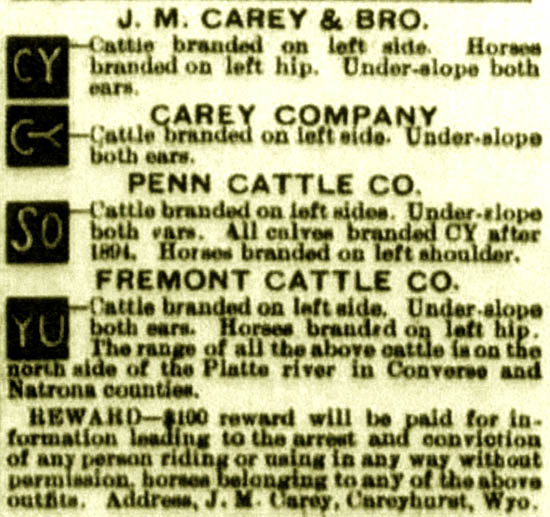
Brands of Carey and Bro..
Although, prior to the Indian Wars, the future site of Casper had been the site of
Fort Caspar and the site of a bridge crossing the Platte River, with withdrawal of the
army the area was abandoned until the coming of the C Y Ranch. The bridge had disappeared and all
that was left by the 1880's were rocks where once had stood the supports for the bridge.
Thus, Casper as a city dates to 1888 when the railroad arrived. The spelling was as
a result of an error when the post office was established.
The earlier Platte River Bridge was built by
Louis Guinard in 1859-1860 and replaced an earlier bridge down stream which had
washed away. The bridge was 810 feet long and was supported by 28 wooden cribbens.
Total cost of the bridge was approximately $40,000. Tolls, depending on the
flood stage, varied from $1.00 to $6.00 per wagon. Before the construction of the bridge the
area was the site of several ferrys, including the Mormon Ferry. The ferry
was guided across the river on a cable. The ferrymen could by varying the angle of the
craft cause the river current to propel the vessel across the river in either direction.
The CY dated to 1876 when Joseph Maull Carey (1845-1924) trailed 12,000 head of cattle
up from Austin, Texas. CY Avenue in Casper is named after the
ranch. J. M. Carey came to Wyoming upon his appointment as District Attorney by President
Grant in recognition of his services in Grant's presidential campaign. Subsequently he became
an associate justice of the Wyoming Supreme Court. He thereafter retained the title of
"judge" throughout the rest of his life notwithstanding his election as United States senator as a Republican in 1890
and governor as a Democrat in 1911. He also was one of the organizers of T.
Roosevelt's Progressive Party in 1912. Judge Carey also served as mayor of Cheyenne, territorial delegate to Congress and was
the author of the bill granting statehood to the territory. During the debate over
statehood he claimed that Wyoming had a population of over 110,000. The population estimate
was able to persuade the winning margin for the bill in the House of Representatives. The
following year the U. S. census revealed that the actual population was somewhat less--62,555.
Judge Carey was a founder of the Wyoming Stock Growers Association and the Cheyenne Club. Ultimately, he
turned management of the family business, J. M. Carey and Brother Cattle Growers, over to his son
Robert D. Carey (1878-1937) who followed in his father's footsteps serving also as both governor and United
States Senator
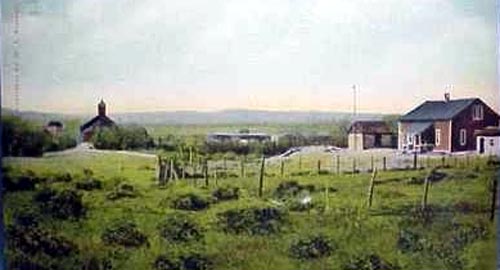
C Y Ranch, undated
Charles W. Eads, who in 1890 established a mining camp known as Eadsville on Casper Mountain, claimed to have been
"the second man that came to Casper." He explained:
"I located there on June 7th, 1888, and when I landed there was just one
man there, and that was John Merritt. He was on the bank of the river,
and was getting his supper. He was frying his meat on a bent stick and
making his coffee in an oyster can. I went up to him and asked if he
had any idea where Casper was, and he said he could hardly say, that he
had been looking for it about a week.
"I told him to come over and help me put up my tent and he could
camp with me. I had a tent and stove and a little grub and he said he
would just put in with me. So the next morning we talked over the
location, and we set up the first tent of the old Casper, and after
that I was familiar with all the transactions of Casper for ten years."
Railroads in the 1880's were as much a real estate venture as they were a transportation companies.
Each railroad had a subsidiary which as the railroads were constructed laid out townsites and sold
lots. In the instance of the Fremont, Elkhorn & Missouri Valley, the real estate subsidiary was the
Pioneer Townsite Company. In anticipation of the arrival of the railroad, several merchants had begun
the beginning of Casper with the establishment of a drugstore, a drygoods store and a restuarant.
The railroad arrived in 1888 and the town laid out approximately a mile west of the early buildings.
It was imparative that the railroad terminus be located in an area where a good fee simple
title could be obtained and which the Railroad could plat, sell lots and deliver good title. The early settlers undoubtedly anticipated that
the sites of their new business could be located on government land.
An examination of real estate records indicated that the
only area on the north bank of the Platte where good title could be obtained was on the
C Y Ranch owned by J. M. Carey and Brother. Thus, two quarter sections were purchased from
Carey about a mile west of where "old Casper" had been located as the site for the new town.

Business in "Old Town" Casper 1888. Left to right: Unidentified, Demorest Home Restuarant, Metcalf & Williams Dry Goods, Pioneer Drugstore.
As indicated, The first
commercial buildings were located in "old" Casper near present-day "A" street and McKinley, about one mile east of the present center of town.
Thus with the filing of the plat for the "new" Town of Casper in October 1888, the businesses depicted above had to be
relocated. The Demorest House Restuarant was operated by Peter A. Demorest (1835-1919) and his wife Hannah (1844-1921). It originally catered to railroad workers.
Metcalf & Williams, a drygoods store, was reputedly
the first commercial building in Casper. It was establish by George W. Metcalf who moved to Casper from Ft. Fetterman where he
had operated a similar business. After relocation, Metcalf and C. C. P. Webel became partners and the
business was re-named as the Webel Mercantile Company.
An early operator of the drugstore was C.F.G. Bostleman. After the move to Center Street, W. S. Kimball became a partner and later acquired the whole
store when Bostleman sold his interest. Kimball was a registered pharmacist, sold jewelry and advertised that he was the "official watch
examiner for the C & N.W.Ry." The store advertised, among
other things, remedies for "Constipation and the Concomitant Evils of Impacted Feces." In 1894 Kimball bought out
Bostleman's interest in the store. Kimball served as mayor from 1903 to 1909.
Kimball's sales motto was "Kinball Handles the Goods."
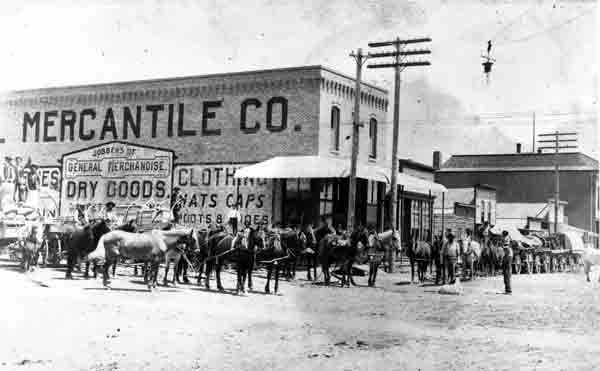
Webels, northeast corner of Center and 2nd Ave.
The hip roofed building in the background is the
Odd Fellows building.
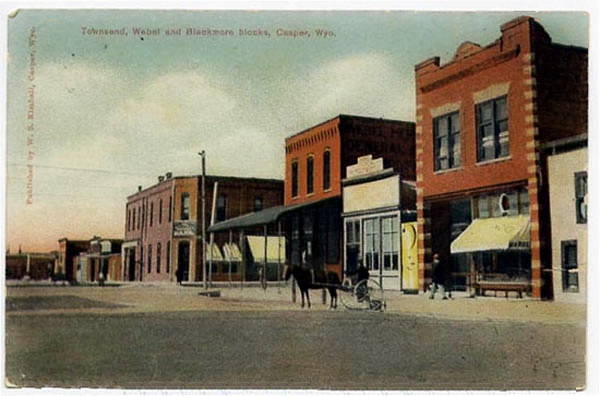
Intersection of 2nd Street and Center, approx.
1905. Postcard published by W. S. Kimball.
C. H. Townsend's Stockmen's National Bank is on the far corner. The Webel's on the
right-hand corner was later replaced by the Rialto Theatre discussed on a subsequent page.
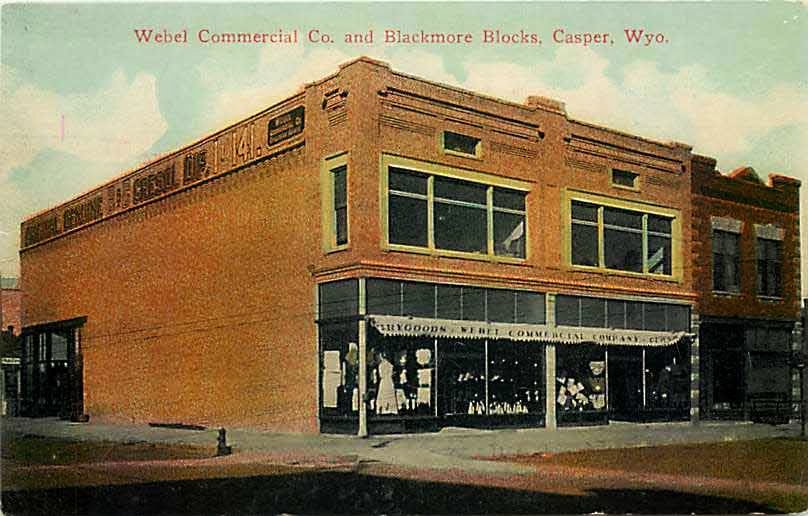
Intersection of 2nd Stret and Center showing Webel's and the Blackmore Grocery Store and meat market.
The brick building on the right in the above two photos (112 E. 2nd Street) is the Blackmore Block constructed in 1907 by Walter A. Blackmore (1863-1923).
The building housed a grocery store. Blackmore moved to Casper from Bessimer after a drugstore he operated there failed. In addition to operating the grocery store,
Blackmore owned the Hat 6 Ranch and with the beginnings of the "oil boom" became the president of the
Wyoming Refining Company. At the time of his death in 1923, he was serving as mayor of Casper. He was killed on April 20, 1923, when his car was struck by a passenger
train west of Casper. He was a Mason.
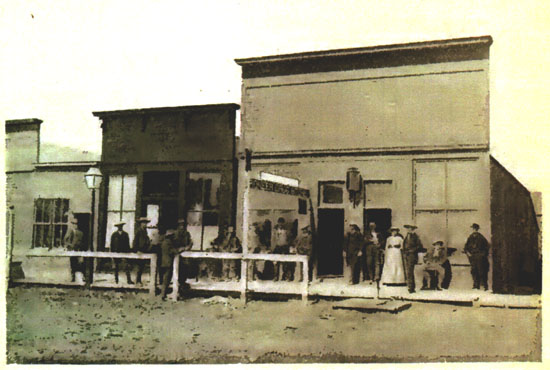
Pioneer Drug Store, Center Street, approx. 1892.
Casper Photos continued on next page.
|